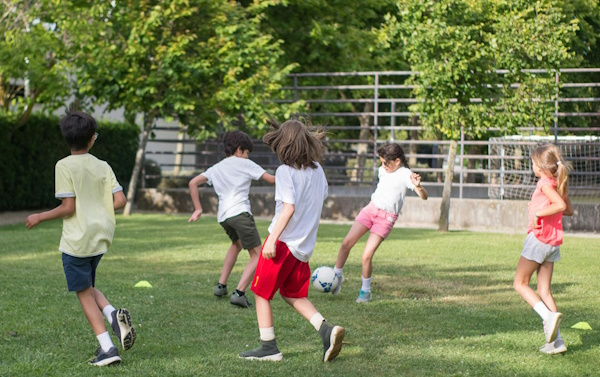Top Healthy Snacks for Kids: Fun & Nutritious Ideas
Finding the perfect balance between snacks your kids will love and those that are good for them can feel like a tightrope walk. But don't worry, you're not alone in this quest for the ultimate healthy snack options. With a little creativity and some guidance, you can easily whip up tasty treats that are both nutritious and kid-approved.
In today's fast-paced world, it's more important than ever to ensure your kids are fueled with snacks that not only taste great but also contribute to their overall health. From energy-boosting bites to vitamin-packed goodies, we've got the lowdown on how to keep your little ones happy and healthy without compromising on flavor. Let's dive into the world of delicious, nutritious snacking that'll have your kids asking for seconds.
Benefits of Healthy Snacks for Kids
When you’re keen on ensuring your kids get the best in terms of nutrition, understanding the benefits of healthy snacks is crucial. These benefits go beyond just satisfying hunger; they play a substantial role in influencing your child's overall health and well-being.
First and foremost, healthy snacks provide essential nutrients that are vital for your child’s growth and development. This includes vitamins, minerals, proteins, and good fats. Unlike processed snacks that often contain empty calories, nutritious snacks fuel your child's body with what it truly needs to thrive.
Moreover, integrating healthy snacks into your kids' diet helps maintain energy levels throughout the day. Children are naturally energetic and require constant fuel. Snacks rich in fiber and protein, such as fruits combined with nuts or yogurt, can keep their energy levels steady, preventing the mid-afternoon slump that sugary snacks might cause.
Healthy snacking also plays a pivotal role in establishing long-term eating habits. By offering a variety of wholesome snacks, you're teaching your children to make healthier food choices, a habit they're likely to carry into adulthood. This can significantly reduce their risk of developing chronic diseases such as obesity, diabetes, and heart conditions later in life.
Additionally, well-chosen snacks can enhance cognitive function, contributing positively to your child’s learning and concentration. Foods high in omega-3 fatty acids, antioxidants, and fiber have been shown to boost brain health, improving memory and cognitive speed.
Lastly, it's worth noting that healthy snacks can also play a part in weight management. By opting for snacks that are both filling and nutrient-dense, your kids are less likely to overeat during main meals or turn to unhealthy snacks out of hunger.
Incorporating these nutritious snacks into your child’s diet requires a bit of creativity and planning, but the benefits clearly outweigh the effort. With each healthy choice, you're setting the foundation for a lifetime of good health and eating habits.
Importance of Finding the Right Balance
When it comes to providing your kids with healthy snacks, finding the right balance is crucial. It's not just about choosing snacks that are nutritious but also ensuring these snacks appeal to your children's taste buds. The goal is to strike a harmony between health and taste, making the nutritious choices enjoyable rather than a chore.
Firstly, consider the nutritional content of the snacks. A balanced snack should contain a mix of macronutrients - proteins, fats, and carbohydrates - along with essential vitamins and minerals. This balance helps in steady energy release, keeping your kids active and focused whether they're at school or playing.
However, the challenge often lies in making these nutritious snacks appealing to children. It's common knowledge that most kids would prefer a cookie over a carrot. The trick is to get creative with how you present healthy options. For instance, making fruit kebabs or blending a colorful smoothie can turn a mundane snack into a fun and tempting option. Here are some tips to keep in mind:
- Incorporate a variety of colors and textures to make the snacks visually appealing.
- Use shapes and themes: think cookie cutters for fruits or vegetables.
- Involve your kids in the snack preparation to spark their interest in healthy eating.
Understanding your child’s preferences and gradually introducing healthier alternatives can also help in this balance. You might find that they’re more receptive to trying new foods when they’re part of the decision-making process.
Remember, the goal isn't to eliminate all treats and sweets. It's about finding healthier alternatives that satisfy those cravings while contributing to their overall health. Moderation is key. Allowing occasional treats, when balanced with nutritious snacks, ensures your children don’t feel restricted and can enjoy a healthy relationship with food.
Tips for Choosing Healthy Snacks for Kids
When embarking on the quest for healthier snack options for your children, it's crucial to strike a balance between nutrition and appeal. Here are some actionable tips to help you navigate this balance effectively.
Focus on Whole Foods: Prioritize snacks that are close to their natural state. Whole fruits, vegetables, nuts, and whole grains are excellent choices. These foods provide essential nutrients and fiber, which are critical for your child's growth and development.
Read Labels Carefully: Even snacks marketed as healthy can be misleading. Look for options with low amounts of added sugars, sodium, and unhealthy fats. The fewer the ingredients list, the better. This practice helps you avoid unwanted additives and preservatives.
- Look for High Protein and Fiber: Snacks with a good balance of protein and fiber can keep your kids feeling full longer. This combination helps stabilize blood sugar levels, preventing energy dips and mood swings.
Make It Fun: Don’t underestimate the power of presentation. Cut fruits and vegetables into fun shapes or arrange them into a colorful rainbow on their plate. The more visually appealing a snack is, the more likely your child will enjoy eating it.
Involve Your Children in the Selection Process: Allowing your kids to have a say in what healthy snacks are available at home can encourage them to try new things. Make a special shopping list together or involve them in preparing the snacks. This engagement not only makes them feel valued but also more inclined to eat what they've chosen or prepared.
By incorporating these tips, choosing healthy snacks for your children can become an easier and more enjoyable task. Remember, the goal is not to achieve perfection overnight but to make gradual, sustainable changes that benefit your child’s health and well-being.
Fruit and Vegetable Snacks
Introducing fruit and vegetable snacks into your child's diet isn't just a healthy choice; it's a crucial step towards fostering a lifelong habit of reaching for nature's bounty when hunger strikes. The vibrant colors and diverse textures of fruits and veggies can be highly appealing to kids, making them an excellent snack option.
For optimal health benefits, focus on whole fruits and vegetables rather than juices or processed snacks that claim to contain fruit or vegetable servings. Whole options retain most of their nutrients and fiber, which are often lost during processing. Additionally, they are less likely to lead to sugar spikes and crashes, providing a more sustained energy source.
Here are a few ideas to make fruits and vegetables more enticing:
- Create Fun Shapes: Utilize cookie cutters to transform fruits and vegetables into fun shapes that kids will be excited to eat.
- Offer Dips: Pair apple slices, carrot sticks, or cucumber rounds with dips like hummus, yogurt, or a light ranch dressing to make them more appealing.
- Make Smoothies: Smoothies are a great way to combine multiple servings of fruits – and even vegetables – in one delicious drink. Adding a handful of spinach to a berry smoothie can boost nutrient intake without compromising taste.
Consider the following breakdown of fruit and vegetable snack options and their benefits:
| Snack Option | Benefits |
|---|---|
| Carrot sticks with hummus | High in fiber and beta-carotene |
| Apple slices with peanut butter | Provides a good balance of fiber and protein |
| Seasonal berries | Packed with antioxidants |
| Cucumber rounds with yogurt dip | Hydrating and rich in calcium |
Remember, the key to getting your kids excited about these healthy snacks is variety and presentation. Rotate your offerings based on seasonal availability to keep things fresh and engaging. Always be on the lookout for new and creative ways to introduce these wholesome choices into their snack time.
Whole Grain Snacks
When aiming to boost your child's intake of healthy snacks, don't overlook the power of whole grains. Whole grains are a crucial part of a balanced diet, offering fiber, vitamins, and minerals necessary for growth and development. Unlike refined grains, whole grains retain all parts of the grain, ensuring your little ones get the maximum nutritional benefit.
One of the simplest ways to incorporate whole grains into snacks is by choosing products made with 100% whole grains. These can include whole grain bread, crackers, and even certain types of popcorn. Look for the "100% Whole Grain" stamp, or check the ingredients list to ensure whole grains are listed first. This small step guarantees you're choosing the most nutritious options available.
Here's a quick breakdown of popular whole grain snack ideas:
- Popcorn: A fun and fibrous snack. Opt for air-popped popcorn and avoid adding too much salt or butter.
- Whole Grain Crackers: Pair these with cheese or hummus for a satisfying snack.
- Oatmeal: Not just for breakfast, add fruits and a drizzle of honey to make it a sweet snack.
- Whole Wheat Pitas: Fill these with your child’s favorite veggies and a dollop of yogurt for a tasty mini meal.
| Snack Option | Key Benefit |
|---|---|
| Popcorn | High in fiber |
| Whole Grain Crackers | Good source of iron |
| Oatmeal | Rich in antioxidants |
| Whole Wheat Pitas | Provides essential B vitamins |
Remember, when it comes to enticing kids with whole grain snacks, creativity is key. Using whole grains as a base, you can add various toppings and fillings to make each snack exciting and different. Get your kids involved in the preparation process to make them more interested in trying new, healthy options. Experimenting with flavors and textures will help find those whole grain snacks that they truly enjoy and keep asking for more.
Protein-Packed Snacks
When it comes to keeping your kids energized and satisfied between meals, protein-packed snacks are a game-changer. Protein is vital for growing bodies, aiding in muscle repair, and helping to keep those little stomachs full until the next mealtime. The trick is to find sources of protein that are not only healthy but also appealing to kids.
One of the easiest ways to incorporate protein into your child’s snack time is through nuts and seeds. Almonds, peanuts, and sunflower seeds are not only rich in protein but also healthy fats that are crucial for brain development. However, if your child attends a nut-free school or has allergies, there are plenty of other options to consider.
Yogurt and Cheese Snacks
Greek yogurt is a fantastic source of protein and can be more appealing to kids when mixed with a bit of honey or fresh fruit. String cheese or small servings of cottage cheese are also excellent protein-rich snacks that most kids love. They're convenient, portable, and best of all, require minimal preparation.
Lean Meats and Plant-Based Options
For a more substantial snack, consider lean meats like turkey or chicken. You can slice them into thin strips and pair them with a dip or use them to make mini wraps with whole grain tortillas. Hummus, made from protein-rich chickpeas, serves as both a delicious dip and a spread for veggie sticks or whole grain crackers.
| Protein Source | Protein Content |
|---|---|
| Almonds (1 oz) | 6 g |
| Greek Yogurt (6 oz) | 17 g |
| String Cheese (1 oz) | 7 g |
| Hummus (1/4 cup) | 4.8 g |
Introducing a variety of protein-packed snacks not only keeps snack time interesting but also ensures your child is getting the nutrients needed for their active and growing bodies. Remember, the key is to keep portions appropriate for snack time and maintain a balance with other nutrient-rich foods throughout the day.
Snacks with Healthy Fats
When it comes to nourishing your child's body, don't overlook the importance of healthy fats. Fats are crucial for brain development, especially in kids. But not all fats are created equal. You'll want to focus on snacks rich in monounsaturated and polyunsaturated fats, including omega-3 fatty acids, that support overall health and development.
Start by introducing avocados and olives into your child's diet. These can be easily integrated into snacks or made into dips. For example, a simple guacamole or olive tapenade can make veggies more appealing. Another great option is nuts and seeds, such as almonds, walnuts, chia seeds, and flaxseeds. They're not just packed with healthy fats; they also offer protein and fiber. Consider making homemade trail mix or adding them to yogurt for a nutritious snack.
Don’t forget about fatty fish, like salmon and trout, which are excellent sources of omega-3 fatty acids. While fish might not be the first thing that comes to mind for a snack, creating mini salmon patties or trout spread on whole grain crackers can be a delightful way to incorporate these into your child's snack regimen.
It's essential to pay attention to portion sizes since fats are more calorie-dense. However, when chosen wisely and consumed in moderation, snacks with healthy fats can be part of a balanced diet that supports your child's growth and development. By incorporating a variety of these fat-rich foods into your child's snack times, you’re not just satisfying their hunger; you're also fueling their body with the nutrients it needs to thrive.
Fun and Creative Snack Ideas for Kids
Offering your children healthy snacks is essential, but making those snacks fun and creative can be just as important to ensure they're excited about eating them. Thinking outside the box with the presentation and preparation of snacks can turn nutritious eating into a fun activity for your kids. Below are some innovative snack ideas that are both healthy and enjoyable.
Make Fruit and Veggie Rainbow Platters: Children love colors, and creating a colorful display of fruits and vegetables can entice them to eat more of these nutritious foods. Arrange sliced fruits and vegetables in the shape of a rainbow on a platter. You could include strawberries, oranges, bananas, green and yellow peppers, and purple grapes. This not only looks appealing but is also packed with vitamins and minerals.
Create Protein-Packed Funny Faces: Use whole-grain crackers as a base and add toppings like hummus or peanut butter. Use sliced veggies and fruits to create funny faces on the crackers. For instance, sliced olives for eyes, a cherry tomato for a nose, and strings of cheese for hair. This snack is rich in protein and fiber, making it both healthy and entertaining.
DIY Yogurt Popsicles: Mix plain Greek yogurt with fresh fruit and a little honey, then pour the mixture into popsicle molds and freeze. Not only is this a great way to cool down on a hot day, but it's also a delightful way to get your kids to eat more dairy and fruit. Greek yogurt is high in protein, and by choosing your fruits, you're adding an extra dose of vitamins.
Incorporating these fun and creative snack ideas into your child’s diet will not only keep them happy and engaged but will also contribute significantly to their daily nutritional needs. Remember, presentation can make a world of difference in how children view healthy foods, turning snack time into an opportunity for both nutrition and fun.
Conclusion
Embracing healthy snacks for your kids doesn't have to be a daunting task. With the right mix of fruits, vegetables, whole grains, protein, and healthy fats, you're setting the stage for nutritious eating that's both fun and fulfilling. Remember, it's all about making healthy food appealing to them. By turning snack time into a creative and enjoyable experience, you're not just feeding their bodies but also nurturing their minds. Let these snack ideas inspire you to explore more ways to present nutritious options in an exciting manner. After all, a little creativity goes a long way in ensuring your kids get the nutrients they need with smiles on their faces.







